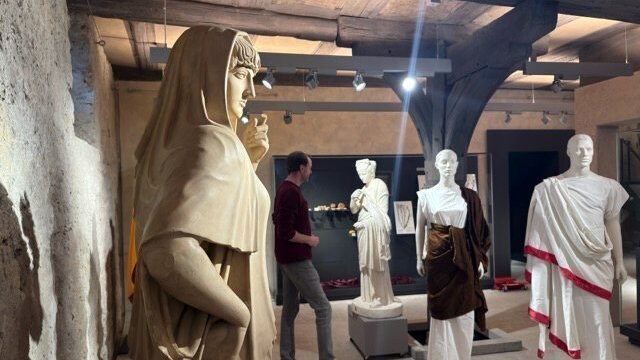
- Knowledge Transfer and Innovation
Published: | By: Stephan Laudien
"The hairstyles of the emperor and empress were of course a model for the Romans," says Dr Dennis Graen, curator of the Collection of Classical Antiquities at Friedrich Schiller University Jena. In addition to Greek fashion, the special exhibition "ENDYMATA: Fashion in Antiquity" will show hairstyles and clothing from the age of Rome from 9 April and change its title to "INDUMENTA".
The heads of statues show elaborate wig fashions that characterised the respective imperial houses. In some cases, blonde hair from Germania was used for this, says Dennis Graen. Emperor Hadrian (76 - 138), on the other hand, wore a beard and thus paid his respects to the Greek philosophers. His bust is a bridge to Greek fashion in the exhibition, which is on display in the Collection of Classical Antiquities at Friedrich Schiller University Jena (Fürstengraben 25). Open on Fridays from 10 am to 12 noon and Sundays from 2 pm to 4 pm, closed on public holidays. Further guided tours are available on request: antikensammlungen@uni-jena.de. Admission to the exhibition is free of charge.
The purple toga was reserved for the emperor
Age-old craft techniques are on display, as are natural fabrics that were used to dye clothing. The exhibits include purple snails from the Phyletic Museum and dye plants from the Haussknecht herbarium. Indigo, saffron and gall apples were used for dyeing. To obtain 100 amphorae of imperial purple, 500 kg of purple snails had to be processed. This is how Pliny the Elder recorded it in his "Naturalis historia". The appropriate quote from the scholar, who died during the eruption of Vesuvius in 79, was found by students during a course on the topic of fashion in antiquity. As fashion in the modern sense did not exist back then, the term "endymata/indumenta", the ancient Greek and Latin terms for cloth and clothing, was chosen as the title of the exhibition.
The colours of clothing became increasingly important in the Roman Empire, says Dennis Graen. While a toga in purple was reserved for the emperor, high-ranking officials wore purple stripes on their robes to symbolise their rank. According to the curator of the Collection of Classical Antiquities, the soldiers' clothing also changed: "The Roman army was not an aristocratic army like the Greek army and the professional soldiers largely wore standardised clothing provided by the state." Ordinary soldiers protected themselves with chain or plate armour, while senior officers wore muscle armour. Examples can be seen in the exhibition.
The desire for embellishment is timeless
Another facet of the exhibition is jewellery and utensils for personal hygiene. These include perfume bottles found in Roman women's graves, as well as Roman signet rings, bracelets and earrings made of gold, silver and bronze. This jewellery and numerous garment clasps demonstrate the skills of the goldsmiths. In addition, make-up utensils, hairpins, combs, mirrors and razors illustrate that the desire for beautification is just as timeless as fashion.
The exhibition will open on Wednesday, 9 April at 6 pm. Several themed guided tours are planned as part of the accompanying programme.
Further dates and information can be found here de (German only).
